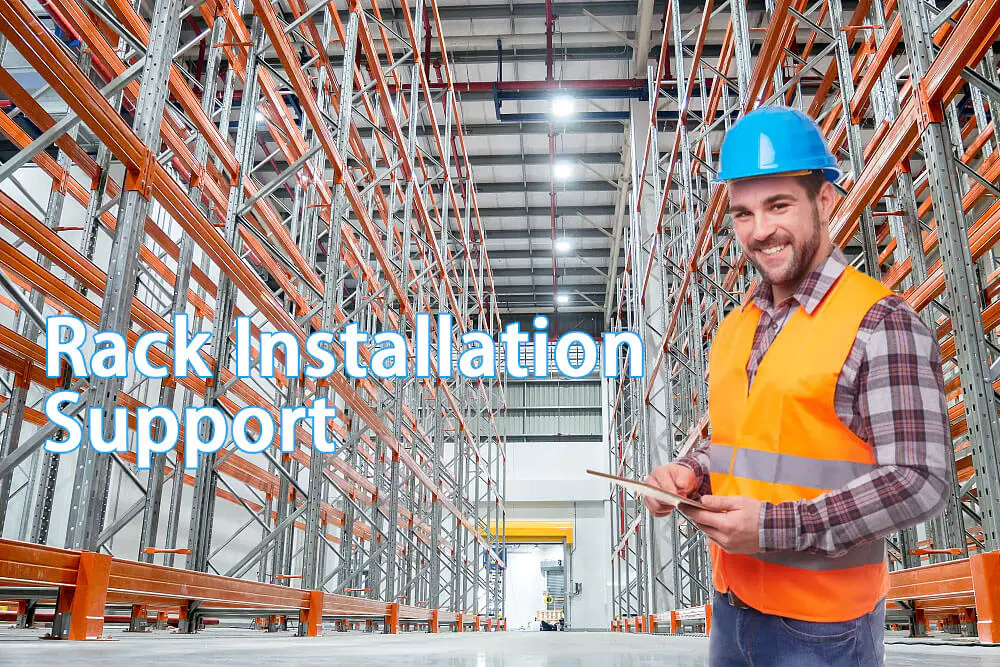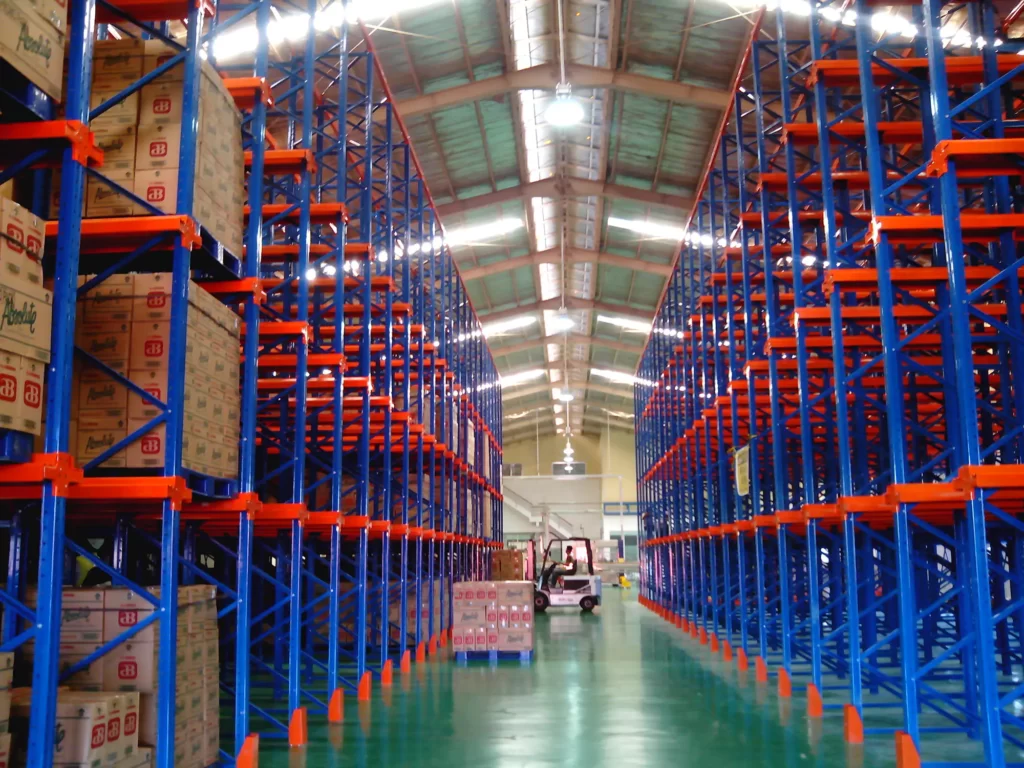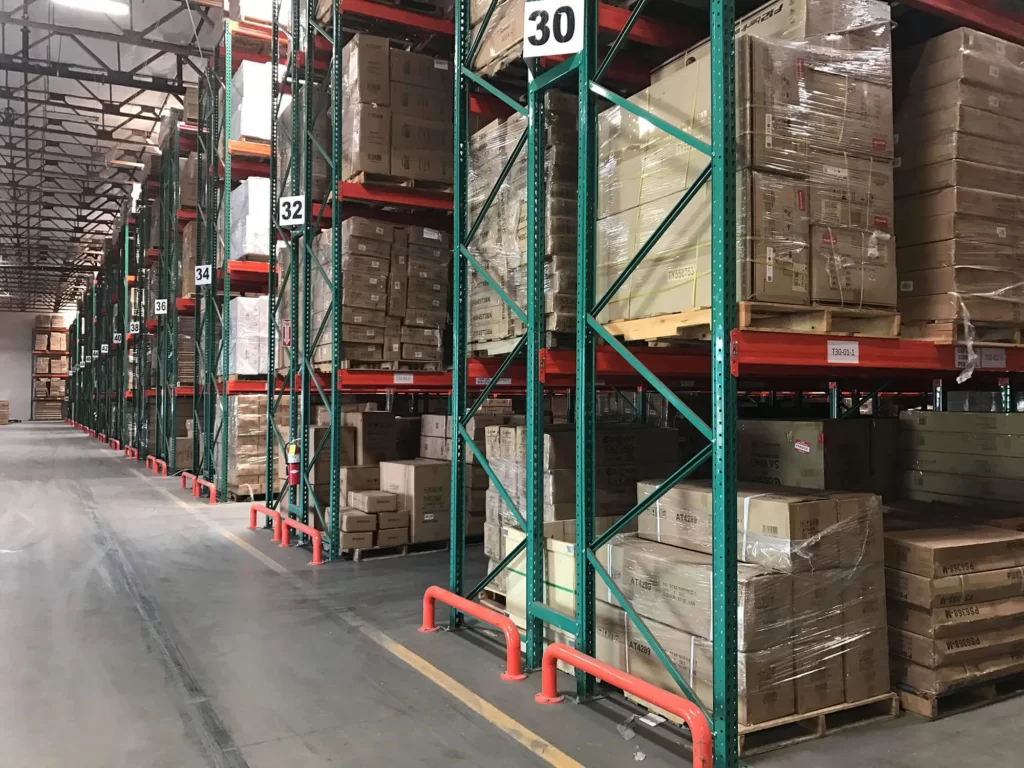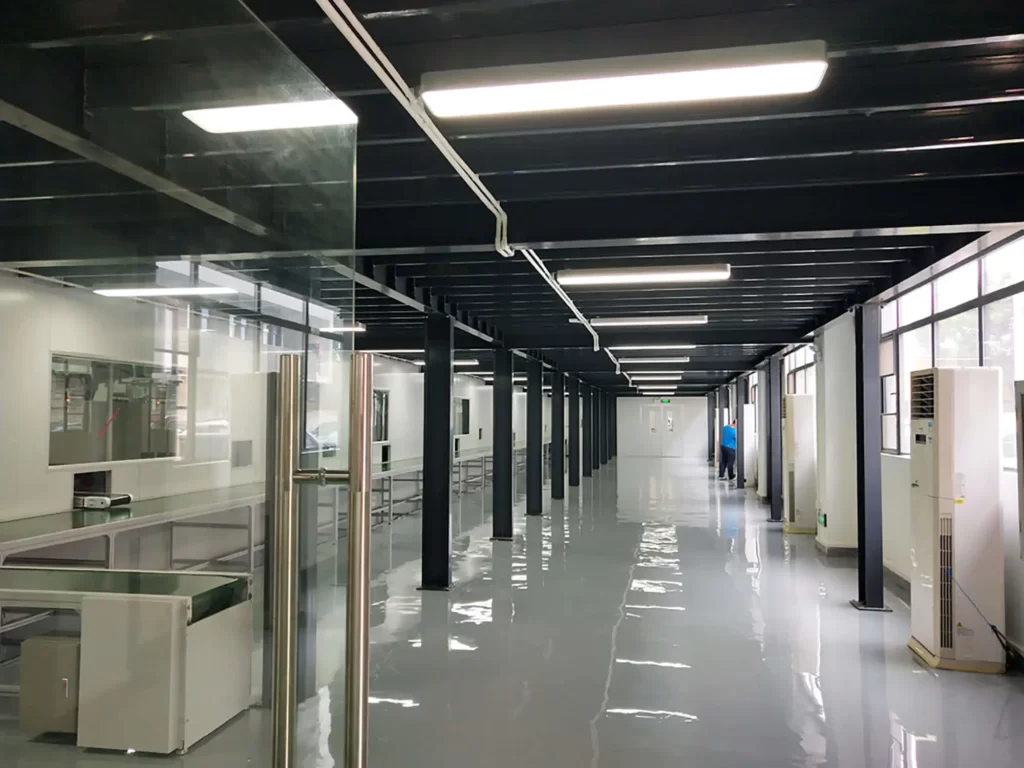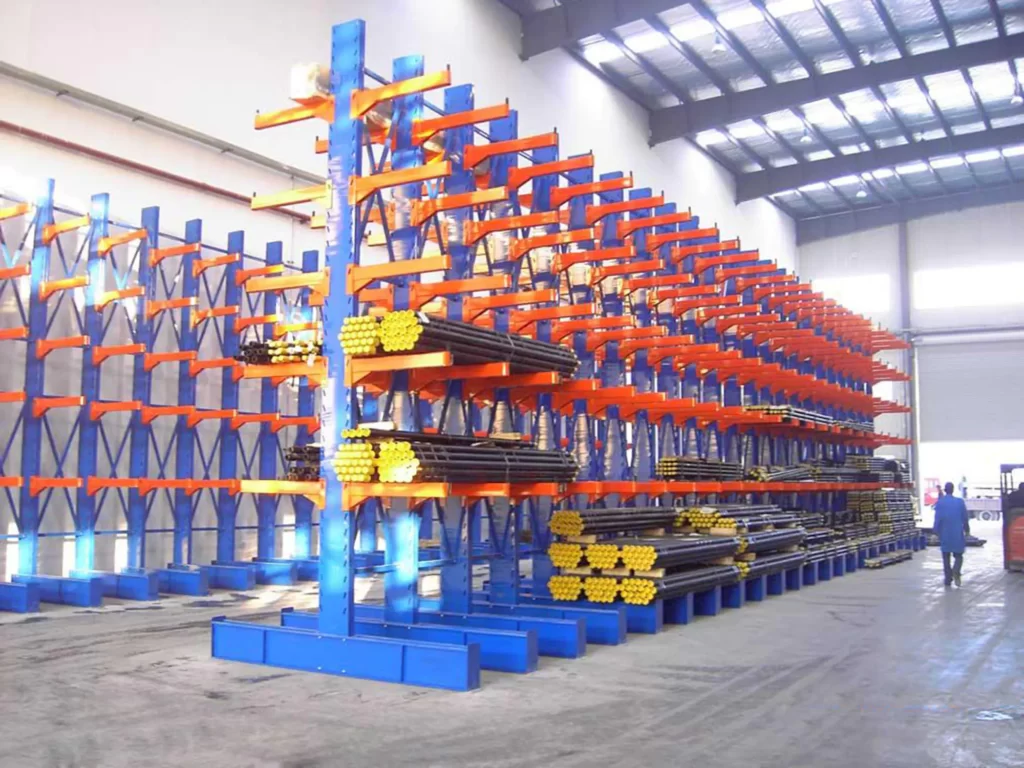A pallet rack is an excellent system that is used to keep the products on top of one another. A pallet racking system uses the vertical space of a warehouse. To use the pallet racks properly, pallet racking installation is a very important step.
Pallet racking must be installed properly if you desire it to function as intended. Using a pallet rack helps to efficiently manage the store of a warehouse.
Without installing pallet racks properly, pallet racks can’t operate efficiently in a warehouse. Improperly installed pallet racking can also pose a significant threat to warehouse safety.
The modern rack system is easy to install. However, one needs proper knowledge and tools to install a pallet rack. Installing a pallet rack by a professional will cost money. But it will also ensure the safety of the pallet racks in the warehouse.
Setting up a rack system needs calculations and extensive planning. In this article, we will discuss the pallet racking installation in great detail. In this article, we will discuss step by step the following things:
This article will be particularly helpful for the following group of people:
- Warehouse managers and owners who want to know about the pallet racking installation.
- Warehouse workers who have an interest in learning the racking installation process.
- People who want to know about the pallet racking installation process.
The importance of proper pallet rack installation.
While reading this article, a question may come into many warehouse owners’ and managers’ minds. Is it necessary to properly install the pallet racks? What if pallet racks aren’t installed properly in the warehouse?
Answering the first question, it is necessary to properly install the pallet racks in the warehouse. If pallet racks aren’t properly installed in your warehouse, you should immediately take action and install them properly.
In our article, warehouse racking collapse, we’ve discussed that incorrect installation is the main reason behind warehouse racking collapse. Here are the top 3 reasons why should you properly install the pallet racks in your warehouse:
Pallet Racking Installation Properly Increases The Safety Of Pallet Racks
If you install pallet racks properly, it increases safety of pallet racks. This creates a safe working environment for the workers working in the warehouse.
Pallet Racks Can Take Loads At Its Maximum Capacity
If pallet racks aren’t installed properly, pallet racks will take loads lower than their capacity. Installing pallet racks properly ensures they can take loads at their maximum capacity.
If you want to know more about “pallet racking weight capacity”, please read pallet racking weight capacity.
Keeps The Goods Stored On The Pallet Racks Safely
We know there are lots of goods stored in the pallet racks vertically. If pallet racks are installed properly, it ensures that the goods stored on the pallet racks are safe.
So, these are the reasons you should install pallet racks properly in your warehouse. Warehouse owners and managers should ensure the proper installation of every pallet rack in a warehouse. Because the collapse of a warehouse rack is bad news for a warehouse.

Tools That Are Needed For Pallet Racking Installation.
As was said earlier, warehouse rack installation needs extensive planning and calculation. See the manual or the assembly instructions included with the product before you start installing the pallet racks.
For the sort of pallet rack you’re installing, you should find clear directions, guidelines, and needs inside. It may happen that the pallet racks came without a manual. When you need particular instructions about installation, get in touch with the manufacturing company.
We know that there are various types of pallet racks in a warehouse. To find out about various types of pallet racks, pallet racking types will be especially helpful. There can be some specific things that are needed to set up a particular type of pallet rack.
Create a list of things that are needed to install the pallet racks. Here we are giving a generic list of things that you may need to install the pallet racks:
- Shelves or decking.
- Chalk line.
- Lifting device.
- A mallet.
- Uprights and beams.
- Tape measure.
- A level.
You may need some additional materials along with these based on the type of pallet racks you are installing.
Another important thing to mention is that you should not install the pallet racks alone. You should have at least one assistant with you who will help you in the installation process.
Pre-Installation Preparation Of Warehouse Racks.
Some preparations need to be taken before the installation of the pallet racks. In this pre-installation process, warehouse managers should make sure that they have prepared the warehouse for installation.
Select The Ideal Rack Configuration
You should select the ideal racking configuration depending on the size of your available area. You should also take into consideration the types of goods you will store while selecting an ideal rack configuration.
After you have chosen the ideal racking configuration for your warehouse, then you should design a rack layout. You can read warehouse racking layout to find out how you can design the layout of the pallet racking system.
Make Sure It Complies With The Local Laws
Verify that this design complies with all applicable federal and state laws before using it. Then send the rack layout to a certified project engineer for endorsement. Before you start your project for installing warehouse racks, you should secure the required building permits.
Verify The Supplies
Verify that all of the supplies have been delivered and are in fine condition. If you are installing racks in phases, repeat these steps for each installation phase.
Having to wait for replacement parts can seriously interfere with your installation timeline. So be careful to finish this inventory as soon as you can after getting the system parts.
Examine, count, and evaluate all rack materials with the project documents. You should do this to confirm the status of the appropriate items. If there are any shortfalls regarding the bill of lading, notify the shipper right away.
Make sure the components are unharmed by inspecting them. To make it easier to find materials, arrange them all in a logical order.
Soil Subgrade And Floor Slab
Ask the owner or the site contact to confirm the racks’ proper placement. You should confirm that the building’s existing floor slab can withstand the loads that will be put on them. Important slab information to remember includes:
- How thick the slab is.
- The slab’s steel reinforcement’s density and strength.
- The concrete’s yield strength.
- placement of joints.
- Any discrepancies with the slab
- The levelness and flatness of the floor.
When the racks are filled, the floor slab should be strong to bear the load from the columns. It should also be strong enough to accept the anchors’ installation. For standard pallet racks, a 6” (inch) thick slab is advised.
The floor’s suitability should be confirmed by the customer’s building engineer. The floor should have been leveled for the rack to be installed plumb.
It’s also crucial to take your facility’s soil subgrade into account. An engineer can assess the subgrade’s rigidity and its bearing capacity. Additional soil site categorization might help guide design requirements, specifically in areas where earthquake is frequent.
Older Buildings
The floor slab may have visible and hidden problems in older structures. For example, the concrete may have cracks or the floor may have sections missing. These could make your rack design more complex.
You can pick a spot on a sound floor if you are anchoring in some bays. However, it’s crucial to bring an engineer if you need numerous aisles. You should have an engineer on board to make sure you aren’t anchoring near or on a compromised location.
Anchoring Close To Slab Expansion Joints
Pallet racks should not be anchored close to slab expansion joints without particular care. During installation, a supervising engineer needs to be present to make sure the design adheres to requirements. The same is true if you’re swapping out broken anchors.
Some Other Things To Do Before The Pallet Racking Installation
Layout the floor by choosing a starting point and drawing chalk lines. Ensure that suitable aisle widths are set. Chalk lines for the down-aisle direction should be drawn starting with the front side of a rack column.
So, these are the things that should be done as a pre-installation preparation of pallet racks.

Lists Of Precautions To Follow Before Pallet Racking Installation.
While installing pallet racks, some precautions need to be followed. These precautions need to be followed for the safety of pallet racks and to increase their efficiency. The following is the list of precautions that needs to be followed before the installation of pallet racks:
The Installation Crew Should Should Be Properly Trained And Follow The Safety Procedure
Ensure that the installation personnel is properly trained in installation techniques. The safety measures that are required to create a secure workplace need to be followed.
For instance, we know racks are made of steel. While installing, part of a rack may accidentally fall on the installation worker. So, it is always better for the installation workers to wear a safety helmet.
Remove Any Kind Of Obstruction
investigate the area thoroughly and confirm the placement of the building columns. You should examine for any further obstacles, which include,
- Electrical panels.
- Lights.
- Ducts.
- Doorways.
- Piping.
If any kind of obstruction is found, it should be marked with tape. It should also be brought to the site contact person’s attention. Make preparations to avoid or get rid of the obstruction.
Locations of the building columns should be documented. The installer should alert the site contact person if there are any areas where aisle sizes are impacted.
Keep Space For The Use Of Firefighting Facilities
No warehouse can claim that they are 100% immune from fire. There are various reasons why fires may erupt in the warehouse. For instance, an electric short circuit may happen and fire can erupt in the warehouse.
If a fire erupts in a warehouse, it can eventually destroy all the goods in the warehouse. Moreover, it can injure the workers in the warehouse. The eruption of the fire in the warehouse is also damaging to the goodwill of the company.
So, warehouse owners should use both the “Prevention and immune” systems to stop the fire. In the prevention system, they should follow all the necessary steps to stop a fire. For instance, if there are flammable liquids in a rack, the rack should be marked specifically.
However, despite taking all precautionary measures, fire can still erupt accidentally in the warehouse. Warehouse managers should keep necessary firefighting equipment like fire extinguishers in the warehouse.
There should be flue spaces in the warehouse racks. Clear vertical lines of view from the ground to the ceiling are referred to as “flue spaces.” This definition of flue space was given by the NFPA. Flue spacing makes sure that the sprinklers have enough space to extinguish flames.
Additionally, clean flue space shows that the racking and goods are well organized and safe. The U.S. Fire Administration states that there are two different kinds of flue spaces. The height of the racks affects the need for flue space maintenance, but the goal is the same.
The two types of flue spaces are as follows:
Transverse Flue Space
This is the area between products that are kept parallel to the loading direction.
Longitudinal Flue Space
This is the distance between each pair of pallet rack rows that are perpendicular to the loading direction.
How does Flue Space work?
These flue spaces enable fires to flow upward from the floor to the ceiling if a fire takes place. As a result, the sprinkler system can effectively reduce the risk of fire. It limits the risk to a more limited area by allowing the fire to flow upward.
If the fire vent is upwards, it lowers the risk of spreading across numerous rows of pallet racks.
So, from the above-mentioned discussion, we can understand the necessity of flue space. While assembling the rack, you should ensure that there is flue space available.
Height Of Each Level Of The Racks Should Be Consistent
We know a rack has many components like a frame, beam, footplate, etc. All of these parts need to be assembled properly to make a pallet rack. While assembling, it is very important to have the same height level as the racks.
Having the same height levels of the racks makes the storing of goods. If the height level of racks is the same, warehouses will not have to buy different sizes of pallets. Warehouse workers can easily calculate adjustable goods in a rack level if the level is of the same size.
Warehouse managers should give proper installation to the installation personnel to keep the height level of racks consistent.
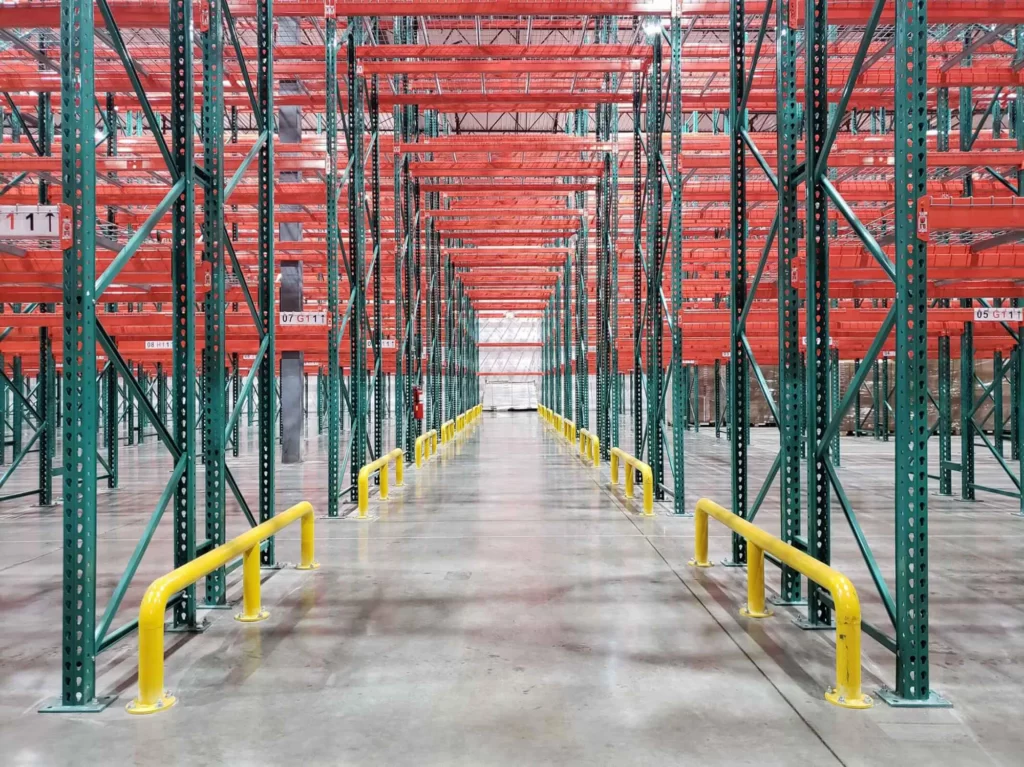
How To Assemble Pallet Racking?
Here, in this section, we will try to explain the pallet racking installation steps in great detail. Before we jump into the pallet racking installation, let us know the parts of the pallet racks. Here are the parts of the pallet racks:
- Beam
- Beam slots
- Upright/column
- Horizontal bracing
- Diagonal bracing
- Footplate
- Row spacer
- Anchor bolt&nut
- Wire mesh deck
- Shelf panel
- Crossbeam
Also, different type of pallet racks has some additional parts of pallet racks. There are some accessories for the pallet racks too. Knowing the names of the rack parts will help you understand the process of pallet racking installation easily.
You need 2 frames as well as at least 4 cross beams to set up your racking. Wire decks as well as pallet support bars are optional extras that are installed last.
Mark the slots for each beam before installation. If you do this, there is no need to be concerned about the beam’s level. Now, we will discuss the step-by-step pallet racking installation.
First Step: Erecting The Uprights
One bay at a time is the simplest and most efficient method to install pallet racks. Set one upright on an outer edge and hold it there by using the chalk outline as a reference. Build the second one across from the first, with the aid of a helper.
Verify that the uprights remain vertical using a level. If not, shim the uprights so that they are straight by placing them underneath. Generally speaking, a small tilt of up to 1/8 inch is acceptable.
For detailed instructions from your manufacturer, read the installation manual. Using the technique suggested in your installation guide, secure the uprights towards the ground.
Second Step: Inserting Of The Rear Beams
Inserting the bottom rear beam should be done first. Put the bottom rear beam within the proper slots in between two uprights with the aid of your assistant. Gently put it in place using a mallet.
If your beams are not slotted, you might have to attach beams to the frame.
Repeat the procedure with the upper rear beam. You may need to employ a raising device following the height of the uprights and the racking system. The uprights and beams will be attached using the lifting device.
Third Step: Inserting The Front Beams And The Formation Of The First Bay
It’s time to place the front beams once you’ve installed and fastened the two rear beams. Place the topmost front beam first, exactly at the same height as the top rear beam. Install the final and the fourth beam after securing it in the same manner as the rear beam.
After you have finished the installation of all four beams, you have constructed the first bay.
Fourth Step: Measuring The Square
You ought to take some action before continuing to the remaining bays. Make sure the first bay measurements as a square using a tape measure. Also, make sure that every space is accurate and equal. This is a crucial step that will prevent problems when putting the shelves later.
Fifth Step: Finish The Remaining Bays
You’ll probably need to add a few additional bays depending on the size of the racking system you want. Repeat the technique you applied to the first bay to assemble the additional bays.
To check that the uprights are straight as well as even, start with the first bay. You should also ensure the heights of all the beams are equal.
Sixth Step: Adding Shelves Or Decking
After the installation of the beams and the uprights, It’s time to install the wire decking or shelving. Select the most appropriate shelf or wire deck for the warehouse if you have enough budget. Consider the predicted weight of the stored goods.
For instance, Wire mesh deck shelving is used for retail, manufacturing, etc.
Seventh Steps: Some Recommended Accessories Of Pallet Racks
The pallet racking installation had been done. To increase the safety of the pallet racks, some recommended accessories can be used. For instance, you can use column protectors. Column protectors will guard against forklift damage on the pallet racks.
You can also use accessories like row spaces, pallet support bars, safety clips, etc. Any pallet rack arrangement can accommodate the installation of the Safety Drop Pin. If a forklift strikes the rack, this clip is meant to safeguard the integrity of the pallet rack.
Another recommended thing is to use signage on the pallet rack system. Different types of signage can be used in the pallet racking system. For instance, signage can indicate the position and level of the racks. It can also indicate the load-taking capacity of the rack.
For instance, load signage will indicate how much load the pallet rack can hold. This will help the workers a lot to avoid the overloading of the racks. To learn more about warehouse signage, please see our article “Warehouse Racking Numbering System“.
So, these are the steps you should follow for a pallet racking installation. However, you may need to follow some additional steps if the manufacturers suggest them in the instructions.
Steps After Pallet Rack Installation.
After the pallet racking installation, you need to follow some post-installation steps. The post-installation steps that should be taken after the pallet racking installation are as follows:
Inspection And Maintenance
The development of techniques and procedures for recurring inspection and maintenance of storage rack systems is crucial.
These inspections should be performed by a certified individual who is an expert on the rack installation requirements. That certified individual should also know about the design of the pallet racks.
Occupational Safety and Health Administration (OSHA) had defined a certified individual with excellence. A qualified individual as defined by OSHA in 29 CFR 1910.21. (b),
“A person who, by possession of a recognized degree, certificate, or professional standing, or who by extensive knowledge, training, and experience has successfully demonstrated the ability to solve or resolve problems relating to the subject matter, the work, or the project.”
The storage racks should undergo regular inspections due to how often they are used. The inspection should be done to look for any indications of damage or deterioration. Any incident that can endanger the rack system should be followed right away by an inspection.
In the warehouse, it may happen that the parts of the warehouse were given to rent to different people. Then, depending on the parameters of their system use, individual owners can establish their inspection schedule.
Ensure that the audit schedule and any findings are completely documented.
Replacing Of The Damaged Anchors
Damaged anchors must be replaced right away. Any anchors that are missing, loose, or damaged directly jeopardize the safety of the goods and the workers. The back and front of the upright footplates need to be firmly attached to the ground.
Warehouse Worker Vs Professional Pallet Rack Installer: Which One Should You Choose?
In the pallet racking installation, you have two choices:
- Installation of the pallet racks by the warehouse workers.
- Installation of the pallet racks by the professional pallet racks installer.
In both of the choices, there are some advantages and disadvantages.
Choosing Professional Rack Installer Is Costly
If you were to tell the warehouse workers to install the pallet racks, it will be cheaper. You can pay the workers hourly or according to the payscale you use to pay them for their work.
However, when you hire a professional rack installer, it will get costlier. Professional rack installers will take more money than workers because of their skills and experience. So, choosing a professional rack installer will cost you more money.
A Professional Rack Installer Will Have All The Necessary Tools
There are many tools and safety precautions needed to install pallet racks. A professional rack installer should come with all the necessary tools and safety precautions.
However, if you want the workers to install the racks, then you will have to buy the tools. Buying the tools that you don’t have for warehouse installation will cost you extra money.
Hiring A Professional Rack Installer Saves Your Energy And Time
Professional rack installers know how to do the work. If you hire a professional rack installer, you can save a lot of energy and time of yours. After finishing the work, an inspection of the rack is enough if you hire a professional rack installer.
But if warehouse workers do the installation, a lot of energy and time of yours is needed. For instance, you will have to guide them throughout the installation process. You will have to check their work from time to time.
So, if you want to save your energy and time, hiring a professional is the best option.
Professional Rack Installer Will Install The Pallet Racks Faster
Professional rack installers are experts in the installation of heavy-duty pallet racks, So, their rack installation will be faster and more accurate.
On the other hand, warehouse workers will install the racks slowly compared to professional rack installers.
Sometimes, it happens that there are lots of pallet racks to install in the warehouse. In circumstances like these, it is recommended to install the pallet racks as soon as possible. The faster the pallet racks will be installed, the faster the goods can be stored on the racks.
So, to save time, professional rack installers are the best option.
A Safe And Stress-Free Pallet Racking Installation Process
While hiring professional installers, one thing you can be assured of is the quality of their work. A professional rack installer will ensure that your rack is installed safely. They will also ensure the prevention of the collapse of the rack.
In addition, you won’t need to take extra stress during or after work by hiring professional installers.
But if warehouse workers do the installation process, there remains a question mark of the safety of racks. If they made any mistake in the installation, The racks may collapse which can cause you monetary damage.
Overall, based on the above discussion, we will prefer to install pallet racks by a professional.
“Mracking” Is The Perfect Solution For Your Pallet Rack Installation Problem.
After reading the previous section, you may be thinking of hiring a professional rack installer. Well, we can solve this problem for you. “Mracking” offers quality pallet rack installation. Here are some of the qualities of our company that will entice you to hire us:
Accuracy And Speed
We offer fast and accurate installation of pallet racks.
Professional Installers
Our installers are highly professional. They have all the necessary tools and skills needed to do the work.
Different Type Of Pallet Rack Installation Services
We know there are several types of pallet racks. We offer different types of pallet rack installation services for our customers.
We Keep In Mind Your Safety
Your safety is our topmost priority. We assure you of the safety of pallet racks during and after the pallet rack installation.
Familiarity With The Guidelines Of Different Rack Manufacturer Companies
Our workers are familiar with the guidelines of different rack manufacturer companies.
A Budget-Friendly Pallet Racking Installation Service For You
We don’t charge higher charges like many other rack installation services. Our installation service is affordable and a great budget-friendly option for you.
This is everything you need to know about the pallet racking installation. Setting up the racking system properly can significantly impact the warehouse’s productivity, effectiveness, and speed.
If you’re looking for a warehouse racking manufacturer or pallet racking installation service, contact us today via the form below!


